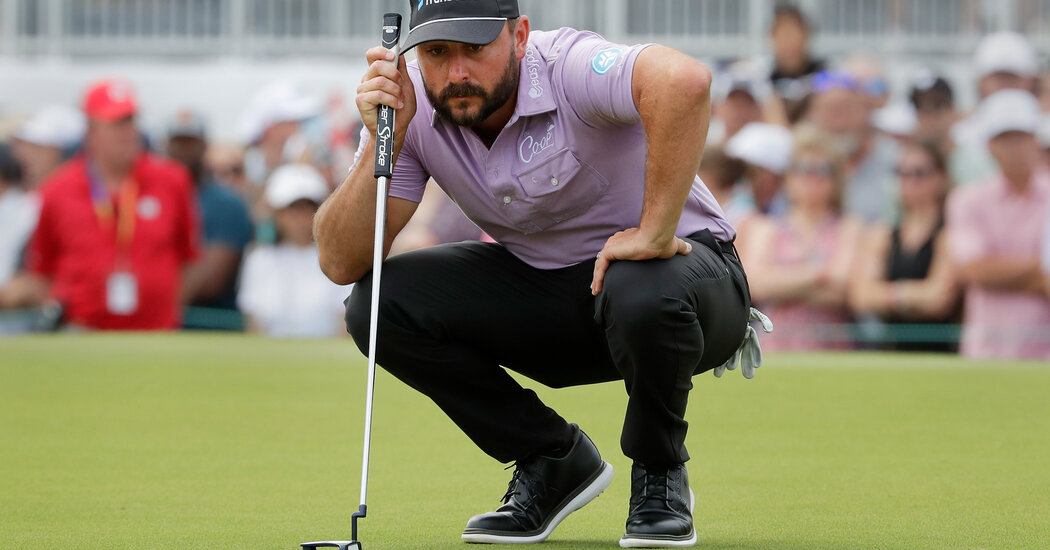Despite a missed putt on the 18th hole at the Texas Children’s Houston Open, Stephan Jaeger still punched his ticket to Augusta National Golf Club, where he will be playing in his first Masters Tournament this week.
There are many ways to get an invitation to the Masters, and Jaeger, 34, found one of them.
But first, he missed a putt that would have clinched a victory over the former Masters champion Scottie Scheffler. Then Scheffler missed a shorter putt that would have forced a playoff with Jaeger.
In the end what mattered was that Jaeger won the tournament, not how he did it, and in doing so he earned an invitation to the Masters.
“I couldn’t have thought, dreamed up a better week to do it,” he said after his victory.
The Masters, the season’s first major for men, is an invitational, which means it is up to the members of Augusta National to send invitations and create the field of men who will compete for the coveted green jacket. This is unique among the major championships.
This year extra attention has been paid to how players secure their invitation largely because of the rise of LIV Golf, the league that has poached a dozen top players. (More on that later.) But how players earn their Augusta invitations has been part of a bigger story around getting into the PGA Tour’s top tournaments, which have the strongest fields and high prize money.
Fair to say that some golf fans are confused, and that some players are upset about being excluded.
What drew new interest in the qualifying process was Joaquin Niemann’s journey to play well, win and get the attention of Fred Ridley, Augusta National’s chairman, who could grant him a special invitation.
Niemann, 28, from Chile, had played in four Masters tournaments. His first invitation came in 2018 after he won the Latin American Amateur Championship, which Augusta supports and whose winner gets an invitation. Last year, he finished tied for 16th place, his best Masters finish.
Normally, a player like that would have enough world ranking points to qualify easily for a Masters invitation. But Niemann went to LIV in 2022, and his ranking fell from 18 in 2022 to 91 today. That put him outside the top 50 who get invitations.
Even though he has played well this year on LIV, the league does not qualify for world ranking points because of its staggered starts, shorter tournaments and team format. Other LIV players in the field have exemptions if they are past major champions or were in the top 50 at the end of last year.
These include Jon Rahm, the defending champion; Phil Mickelson, a past champion who contended last year; and Brooks Koepka, who finished second last year before winning the P.G.A. Championship, which comes with five years of Masters invitations.
So Niemann, whose representative declined to make him available, took to the global road and played on various international tours to showcase himself to Augusta National. He won the Australian Open last year and notched top 10 finishes in three other international tournaments in Australia; Dubai, the United Arab Emirates; and Oman. He also won two LIV events.
Augusta has a history of inviting the best international players. In the 1980s, it introduced Bernhard Langer of Germany, Greg Norman of Australia and Seve Ballesteros of Spain to the world of golf.
Neimann’s plan worked. He received one of three special invitations that went to international players not already in the tournament.
“The Masters Tournament has a longstanding tradition of inviting leading international players who are not otherwise qualified,” Ridley said in February in announcing the special exemptions. “Today’s announcement represents the tournament’s continued commitment towards developing interest in the game of golf across the world.”
Niemann was the only LIV player who wasn’t a former Masters or major champion to get a special invitation. Talor Gooch was ranked 58th in the world when he tied for 34th place at last year’s Masters. He received that invitation because he had been within the top 50 at the end of 2022, which is one of the criteria. He then went on to win three times on LIV that season en route to being named LIV’s player of the year.
Yet Gooch, who is ranked 550th in the world, did not receive an invitation this year and wasn’t happy about it.
“If Rory McIlroy goes and completes his grand slam without some of the best players in the world, there’s just going to be an asterisk,” he said. “It’s just the reality.” McIlroy has won three of the majors, but lacks the Masters.
Few agreed.
So what are the various ways into the Masters? The most coveted is as a past champion. They get a lifetime invitation, though they’re encouraged to stop when they’re not competitive. This year was supposed to be Langer’s final Masters at 66, before he was injured.
Next to that, winning one of the other three major championships gets a player five years of invitations, the Players Championship gets three, and an Olympic gold medal winner gets one invitation.
To honor the tournament’s amateur roots, invitations go to the winner and runner-up of the United States Amateur Championship and the winners of the British amateur, Asia-Pacific Amateur and the Latin America Amateur. The winner of the N.C.A.A. championship also receives an invitation.
Stewart Hagestad, the reigning United States Mid-Amateur champion and a Walker Cup stalwart, will be playing in the Masters for the third time, having won the Mid-Amateur in 2016, 2021 and 2023. He made the cut in 2017, his first year, and won the award for the low amateur.
The rest of the invitations are based on how people have played in recent major championships as well as anyone who won a PGA Tour event in the previous year.
This year it totals about 90 players, a small field for a major championship. The other three majors have qualifying processes. The United States and British Opens are for anyone who can play their way in. The PGA Championship creates its field from touring and club pros.
Yet the split between the PGA Tour and LIV has created a complex situation beyond the Masters: which players get to play into the new Signature Events on the PGA Tour. These events have large purses, limited fields and in some cases no cuts. They’re not majors, but they’re at top courses with stout competition.
Like the Masters, the top 50 in the world golf rankings get into the Signature Events. But then it’s a scramble to fill other, limited spots at some other events. And it’s all new this year.
So, the PGA Tour partnered with Aon, the risk management consultant, to brand the groups that swing into and out of contention, the so-called Aon Next 10, the players who have moved into spots 51 to 60, and the Aon Swing 5, those who do well in the tournaments leading up to the Signature Events.
It’s been even more confusing for fans, and a scramble for players, because who gets into what is a moving target.
Andy Weitz, chief marketing officer at Aon, who said the company brought the idea to the PGA Tour, sees it differently. That confusion is an opportunity to show how the best golfers in the world play over the season.
“We were impressed by the modeling that showed a lot of movement in the top 50 in the course of the year, particularly in numbers 30 to 50,” Weitz said. “It’s fluid in a meaningful way. It creates interesting moments.”

